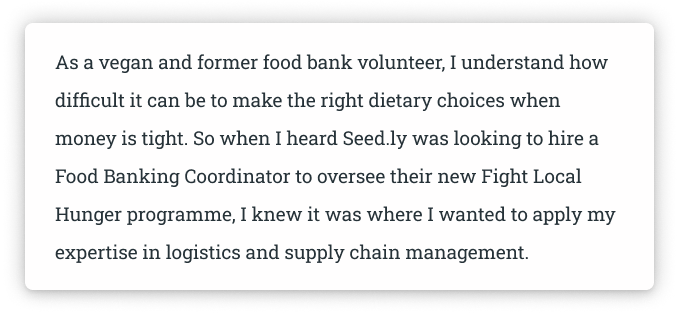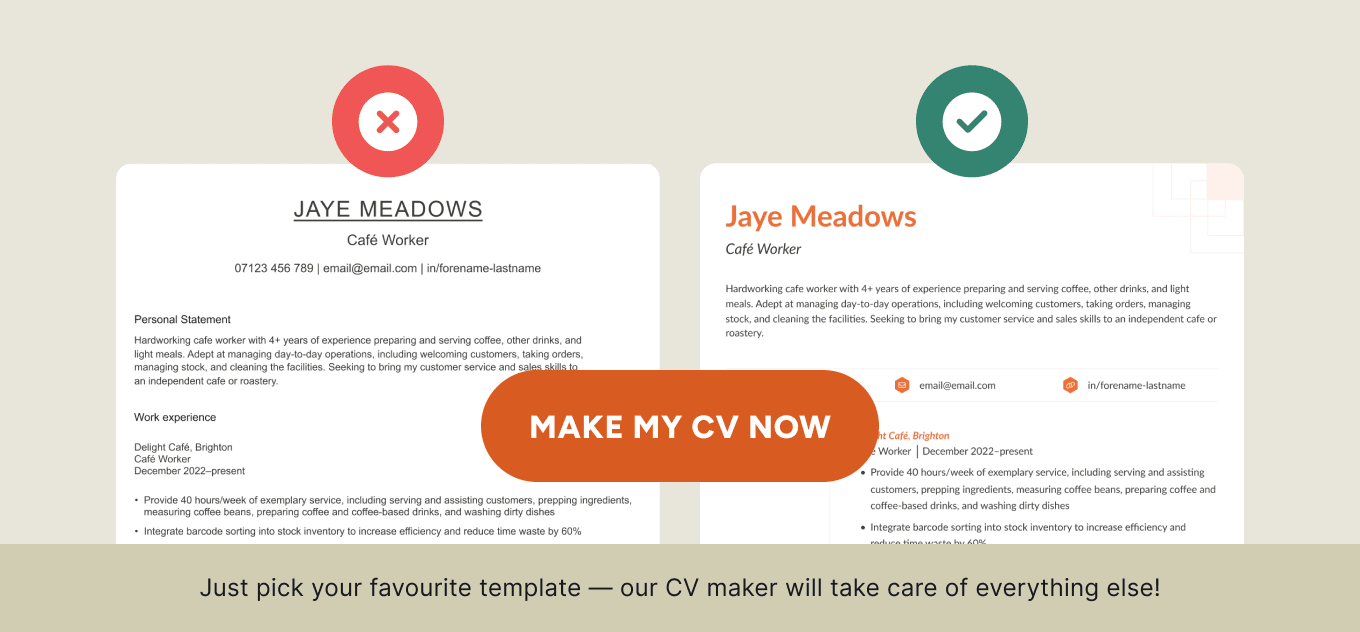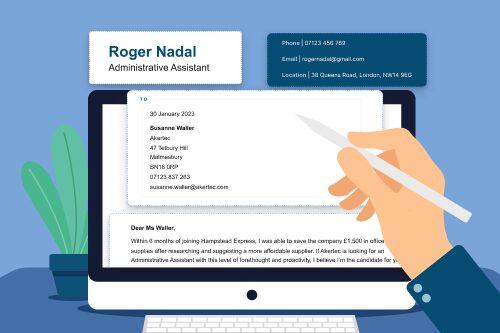As you job-hunt in 2024, writing a cover letter will more than likely be the key to your success.
To help you make a covering statement that stands out, our certified experts put together 20 tips for writing a job-winning cover letter.
1. Make a new cover letter for every application
Sending one cover letter for all your job applications doesn’t help you stand out. In fact, generic cover letters can hurt your chances of getting a job interview.
Employers want to see that you’ve put some thought into your application. So create a new cover letter that addresses the specific job requirements for every position you target.
2. Research the company
To decide what to include in your cover letter, research the company. Your research should answer the following questions:
- What are the company’s goals?
- What does the job involve?
- What kind of candidate is the company looking for?
- How do you fit the company’s culture?
Once you’ve answered those questions, write your cover letter to show how your skills and experience will benefit the company.
For example, if one of the company’s goals is to expand into new markets, you could make a statement like this in your cover letter:
I read in Forbes that your strategy includes expansion into Japan. My experience includes 3 years of work in Tokyo, and I believe my industry connections and understanding of the culture would help you accomplish that goal smoothly and quickly.
3. Read cover letter samples for inspiration
If you’re still unsure how to begin writing, read industry-specific cover letter examples and look at the best cover letter examples of 2023 for inspiration on what to include in your cover letter.
4. Use the right tone
Your cover letter’s tone depends on your industry and experience level:
- Creatives – Use a playful, upbeat tone to express your creativity
- Traditional professionals (e.g., lawyers, business analysts) – Write in a straightforward, serious style to show your professionalism (similar to writing a letter of resignation)
- Educators – Be eloquent, articulate, and concise to demonstrate your communication ability
- Experienced applicants – Use powerful, straightforward language to emphasise your leadership skills
- Inexperienced candidates – Focus on your relevant training and skills if you’re applying for your first job (or writing a career change cover letter) to show how your career goals match the target position
Never be negative. For example, even if you hate your current job, don’t say so in your cover letter, or employers will view you as a potential negative influence in their company.
5. Craft an attention-grabbing opening paragraph
Employers may decide within a few sentences whether to skip over your cover letter or continue reading it. So you’ve got to learn how to start your cover letter off strong.
To determine what will best catch the reader’s attention, consider your audience:
- If the company culture is laid-back, use tasteful humour or passion to show your personality
- If the company culture is formal, start by describing how your experience and skills will benefit the employer, or highlight your top accomplishments
Here’s an example of a catchy opening paragraph for a laid-back company:
If you’re like most people, you saw the Boots Pharmacy advert that aired last Christmas. I’m the person who pitched the idea for that advert — and that’s just one of the many reasons why I’m certain I’d enhance your creative team.
Here’s an example of an effective opening paragraph for a more formal company:
As the sales manager for Xtreme Ltd., I’ve created and implemented strategies that have increased revenue by £50,000 and grown our clientele by 23% within 2 years. I’d like to replicate this success at BuyGoods Ltd.
6. Explain what motivated you to apply for the job
When faced with two similar applicants, employers always choose the applicant who is more enthusiastic about working for their organisation.
So clearly demonstrate your motivations for applying in your cover letter.
There are several ways you can explain your reasons for applying. Here are a few ideas to get you started:
- Show an interest in the company culture
- Explain how you share the company’s values
- Describe your eagerness to work in the company’s industry or sector
- Express appreciation for the company’s products, services, or achievements

7. Highlight your transferable skills
In addition to technical skills, employers look for candidates with skills that transfer well between industries and fit into their company culture.
Impressive transferable skills include:
- research and analytical skills
- leadership
- teamwork
- organisation
- time management
- resourcefulness
- communication skills
8. Add hard numbers and examples
Rather than just listing your daily responsibilities at your previous job, use hard numbers and examples to give the recruiter a better understanding of your skills and achievements.
Here are two examples of cover letter statements that are bad at first, but jump off the page when the writer adds context:
Bad
- Helped students score higher in their A-Levels to increase their prospects
Good
- Developed and implemented a Chemistry curriculum that produced a 97% A-Level pass rate for 2 consecutive years
Bad
- Improved our website ranking on Google’s search engine results page (SERP)
Good
- Created content strategies that reduced our bounce rate by 42% and kept our website at number 1 on Google’s search engine results page (SERP) for 6 consecutive months
9. Cut clichés
Cover letter clichés don’t work because:
- they’re vague and don’t show the recruiter what makes you unique
- the recruiter can misinterpret them as a disguise for your lack of experience
Rewrite overused phrases like:
- I think outside the box
- I’m solution-driven
- I’m detail-oriented
- I’m a go-getter
- I think I’m a perfect fit for this job
- I’m highly motivated
- I work well under pressure
The above phrases don’t demonstrate how you’ve applied your skills. If you want to highlight attention to detail, the ability to work under pressure, or similar core skills, use relevant examples to display your best traits.
For instance, you can show you work well under pressure with a statement like this:
As a Marketing Specialist at H-Tek, I regularly completed urgent projects without losing quality.
10. Close with a call to action
Request an interview at the end of your letter to:
- show the recruiter you’re committed and ready for the next phase
- indicate you can take initiative
- demonstrate confidence and assertiveness — qualities employers value
Your call to action should repeat the contact information in your cover letter’s header, so the employer doesn’t have to search for it.
Here’s an example cover letter ending with an excellent call to action:
If you’d like to know more about my skills and achievements, please contact me at davidred@gmail.com or on 07412 345 678.
11. Proofread
Spelling, punctuation, grammar, and formatting mistakes make you appear sloppy. To avoid embarrassing errors:
- read your cover letter out loud to find mistakes you missed
- ask a friend to proofread
- use online programs like Grammarly, Hemingway App, and ProWritingAid to spot errors and improve your writing’s quality (remember to switch these tools to British English)
12. Keep your cover letter on one page
Your cover letter’s length should have 250–450 words spread across 3–4 paragraphs and fit on one side of an A4 page.
A longer cover letter will be time-consuming to read and could be misinterpreted as a sign of poor communication. And the harder your cover letter is to read, the more likely the employer will put your application in the bin.
13. Pick an easy-to-read font
Your cover letter font should be:
- professional
- easy to read
- between 10.5 and 12 pts
The best fonts for CVs — such as Cambria, Arial, and Georgia — are also perfect for cover letters. Use a cover letter builder and CV maker that offer professional templates to ensure your fonts are optimised.
14. Apply standard margins and line spacing
Optimise your covering letter by using UK-standard margins and line spacing:
- Margins: 1.27–2.5 cm
- Line spacing: 1–1.5 spaces
If you apply non-standard margins and spacing, your cover letter will either have too much white space or be overstuffed with text. Either way, you’ll come off as unprofessional to your target employer.
15. Make your cover letter stand out with a colourful header
Make your cover letter stand out by putting your name and contact information in a colourful cover letter heading.
Here’s how to format your header:
- Write your name in a large, bold font
- Write each element of your contact information on a new line using single-line spacing, or write them on a single line separated by vertical bars (|) or slashes (/)
- Write the date on the first line under your header (for example, 5 December 2023)
- Use colours like dark green, navy blue, maroon to catch employer’s eyes
Quality cover letter templates have preformatted headers that will help you save time. They also include just the right amount of colour!
Here’s an example of a colourful cover letter header that’ll make your cover letter stand out:

16. Left-align the employer’s contact information
Format the employer’s contact information as you would if you were writing it on an envelope.
Write your contact’s name, company address, phone number, and email address in a left-aligned, single-spaced list, like so:
Cindy Lin
Big Dreams Inc.
19 Crumpet Street
Manchester
M1 1EZ
07123 456 789
cindy.lin@gmail.com
17. Start with a professional greeting
Your cover letter’s greeting is a great place to show that you’ve done your research and tailored your application to the position. If you know the contact person by name, use:
Dear [Mr/Ms/Mx] [Contact Person’s Surname], (e.g., Dear Mr Jones,)
Here’s how to address a cover letter if you can’t find the contact person’s name:
Dear [Company or Department Name], (e.g., Dear Marketing Team,)
Don’t use phrases like ‘To Whom It May Concern’ or ‘Dear Sir/Madam’ to start your cover letter, as they’re clichéd and impersonal.
18. Include a bulleted list
Use bullet points in the middle of your cover letter to highlight your qualifications without taking up too much space. Bullets draw the recruiter’s eyes and make your cover letter easy for the employer to quickly scan to see if you’re a good fit for the role.
19. Pick an appropriate sign-off
The correct ways to sign off your cover letter are:
- ‘Yours sincerely,’ if you’ve addressed the contact person by name
- ‘Yours faithfully,’ if you addressed a job position or department in your greeting
20. Sign your name — and format it correctly
If you’re sending a digital copy of your cover letter, press ‘Enter’ twice to create a line of empty space after your sign-off, and then type your name. Here’s an example of what your sign-off should look like:
Yours sincerely,
Jenny McConnell
When you send your cover letter by post or submit it in person, leave 3–4 lines after your sign-off before typing your name. Sign your name in the resulting blank space.
An example of cover letter tips in action
Here’s an example of a cover letter that follows the tips above to convince the employer that the applicant deserves a job interview:

Standout Cover Letter Template (Text Version)
MAX AMBERSON
Business Development Specialist
18 Fashion Street
Watford
WD2 9KS
07749-123-456
m.amberson@email.com
linkedin.com/in/max.amberson
Erick Benson
38 Bolton Street
London
E2 E9L
02071-234-567
erick.benson@gmail.com
28 January 2023
Dear Mr Benson,
I’m thrilled to apply for the Business Development Executive role at Vanguard Economics. With a solid background in relationship management, I’m well prepared for the responsibilities of this job.
Having worked for Sunshine Consultancy for 2 years, I understand what it takes to generate leads for clients. In my role as a Business Development Associate, my ability to create persuasive one-to-one communications enabled my team to close 3 deals worth a total of over £2 million.
Below are some of my other key achievements:
- Assisted in the production of an immensely successful 2021 industry white paper that was downloaded over 2,000 times in its first 6 months
- Delivered 6 highly persuasive client pitches, receiving high praise from my supervisor, Ana Schmitt, for my excellent written and verbal communication skills
- Leveraged CRM software to monitor key accounts, helping secure 90% of forecasted deals
Thus far in my career, I’ve seen too many consultancies prioritise client quantity over providing quality services. Vanguard Economics, however, stands out for the personalised approach it takes to meet the needs of its clients. Working with you is an opportunity to learn from the best people in the business, and I would be delighted to join your team.
Moving forward, I would love for us to meet in person to discuss my experience and how I can contribute to your team. You can reach me at m.amberson@email.com or 07749-123-456.
Yours sincerely,
Max Amberson
Download Cover Letter Template
Common cover letter help FAQs
Still unsure of how to write a convincing cover letter? Here are three questions commonly asked about writing an effective cover letter for a job:
- What should be avoided in a cover letter?
- How do you show enthusiasm in a cover letter?
- How do I make my cover letter stand out with no experience?
1. What should be avoided in a cover letter?
Avoid including the following things in your cover letter:
- Lies and misrepresentations about you and your experience
- Examples and data that show you underperformed
- Your salary expectations (unless the employer specifically requests this information)
- Information you want kept private
2. How do you show enthusiasm in a cover letter?
Here are two ways to show enthusiasm in a cover letter.
1. Show you know about the company
Demonstrate your knowledge of the company by mentioning company values, products, or the industry in which the company operates.
Showing the employer that you understand their organisation and are motivated to work with them indicates that you’ve thought carefully about the opportunity and will take your future responsibilities seriously. Furthermore, discussing your interest in the company tells the employer that your cover letter was written for them and them alone.
2. Write in an active voice
Phrases like ‘responsible for’ and ‘tasked with’ are dull and make you appear to lack confidence. Use the active voice (e.g., ‘I oversaw’ instead of ‘I was responsible for’) to show the employer you can take initiative and work independently.
Similarly, be careful about underselling yourself with modest language. Phrases like ‘got to grips with’ or ‘wrapped my head around’ shrink your achievements and don’t inspire confidence in the employer.
3. How do I make my cover letter stand out with no experience?
Writing a cover letter without any work experience might seem intimidating. Here are two ways you can convince the employer you’re qualified to do the job despite not having experience:
- Emphasise relevant skills. If you’re a recent graduate, focus on your education or other formal qualifications. If changing careers, focus on your transferable skills, work ethic, and any unique benefits you can offer the hiring team.
- Offer potential solutions. Explain how you can help the company address any challenges or goals mentioned in the job advert or other company media. For example, if the company is expanding into a foreign market, highlight any relevant language skills or cultural knowledge you possess.
More FAQs about writing your job application
Here are the answers to even more questions you might have about your job application:






